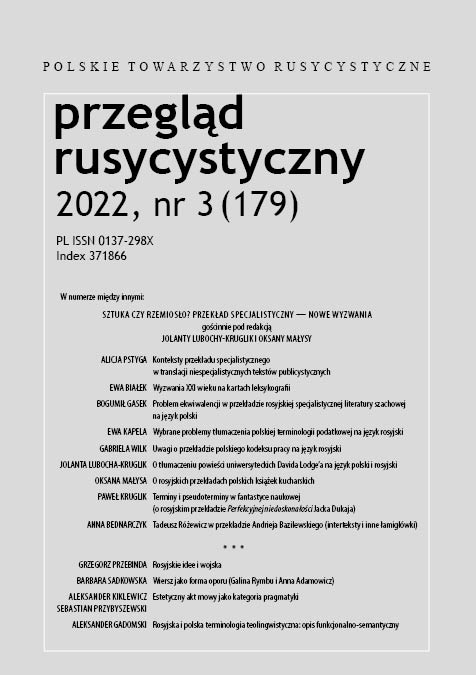ЭСТЕТИЧЕСКИЙ РЕЧЕВОЙ АКТ КАК КАТЕГОРИЯ ПРАГМАТИКИ
AESTHETIC SPEECH ACT AS A CATEGORY OF PRAGMATICS
Author(s): Aleksander Kiklewicz, Sebastian PrzybyszewskiSubject(s): Pragmatics, Theory of Literature, Stylistics
Published by: Polskie Towarzystwo Rusycytyczne
Keywords: pragmalinguistics; linguistic communication; literary pragmatics; discourse; aesthetic speech acts;
Summary/Abstract: The authors treat aesthetic speech acts as stimulating, i.e. within the category of determining speech acts (which also includes directive, interrogative, vocative and creative acts). A characteristic feature of stimulating speech acts is the na- tivistic nature of the determined mental state of the addressee. In formal terms, the peculiarity of aesthetic speech acts is that the use of discrete (lexical or grammatical) exponents of the illocutionary function is not possible in this case. To implement the aesthetic function, various elements of the part of the utterance containing information about the area of reference of the pragmatic function are used: 1) the semantic content of the text or utterance; 2) its form and structure; 3) context and communication situation; 4) translation of text/message, including the media. Due to their functional and formal features, aesthetic speech acts are divided into several subtypes: 1) macro-, meso- and micro-acts; 2) free vs. complementary acts; 3) determining the feeling of beauty or ugliness; 4) communicative vs. non-communicative. Keywords: pragmalinguistics, linguistic communication, literary pragmatics, discourse, aesthetic speech actsThe authors treat aesthetic speech acts as stimulating, i.e. within the category of determining speech acts (which also includes directive, interrogative, vocative and creative acts). A characteristic feature of stimulating speech acts is the na- tivistic nature of the determined mental state of the addressee. In formal terms, the peculiarity of aesthetic speech acts is that the use of discrete (lexical or grammatical) exponents of the illocutionary function is not possible in this case. To implement the aesthetic function, various elements of the part of the utterance containing information about the area of reference of the pragmatic function are used: 1) the semantic content of the text or utterance; 2) its form and structure; 3) context and communication situation; 4) translation of text/message, including the media. Due to their functional and formal features, aesthetic speech acts are divided into several subtypes: 1) macro-, meso- and micro-acts; 2) free vs. complementary acts; 3) determining the feeling of beauty or ugliness; 4) communicative vs. non-communicative.
Journal: Przegląd Rusycystyczny
- Issue Year: 2022
- Issue No: 179
- Page Range: 237-259
- Page Count: 23
- Language: Russian

